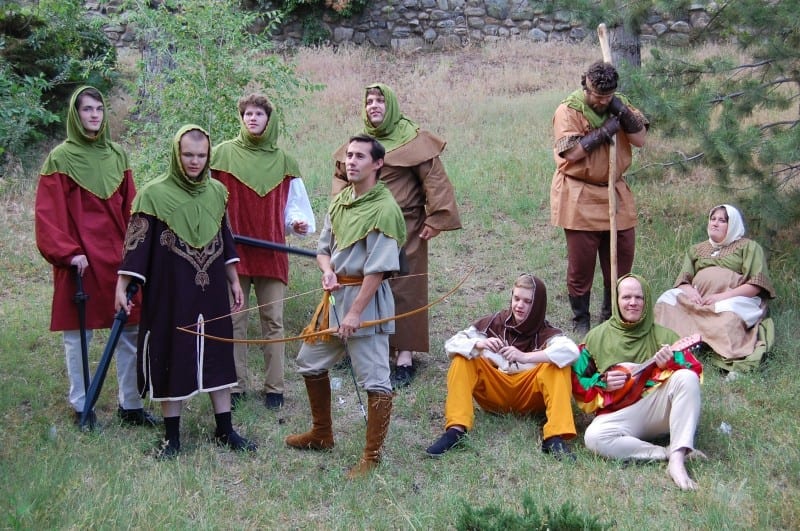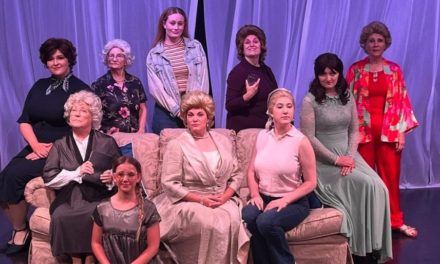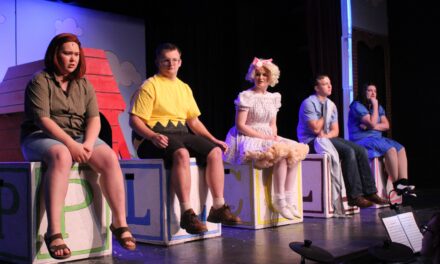CLEARFIELD — With a story as often told as the legend of Robin Hood, it would seem difficult to bring something entirely new to the stage. However, Ed Farnsworth‘s version, Robin Hood: Legend of the Sherwood Bandit, with music by Anthony Buck, led up to the classic moments of the tale with scenes to establish believable characters who had complex choices to make. Where many versions of this legend address only the “what” of the account, Legend of the Sherwood Bandit addressed a possible “why.” Suddenly, familiar characters became symbols for the choices people have made in any period of time, between loyalty to friends, God, country, promise, and self.
This telling centers on the evolution of Robin Hood (Justin Lee) from a playful noble to a selfless hero. Instrumental in this transformation is Maid Marian (Kellie Chapman), a childhood friend who expects a different type of nobility from Robin than he is initially willing to uphold. Robin is surrounded by his traditional band including Will Scarlet (Trevor Hartvigsen), Little John (Brandon Garlick), and Friar Tuck (Andrew McAfee), and is opposed by Prince John (Phil Tuckett), the Sheriff of Nottingham (Chris Greenwood), and Sir Guy of Gisbourne (Ed Farnsworth). But it takes more than just the expected characters to effect a change in Sir Robin of Locksley. Legend of the Sherwood Forest relies on new character Rowena (Liz Christensen) to portray the consequences of the selfish decisions Robin could have made along the way. Martha (Jeana Forthman), Little John’s wife, anchors the Sherwood bandits emotionally, and Much the Miller’s Son (Forrest Scott) balances what could have become a darkly emotional tale with the perfect amount of comedy.
Although Legend of the Sherwood Bandit was interesting because its themes were relevant, it was relevant because its characters were believable. This authenticity grew from scenes with comfortable dialogue that established character while advancing the plot. Though delivered with appropriate accents and in an old world vernacular, the playful interactions between the Sherwood bandits felt very much like watching a group of present day men gathered around an Xbox. And the subsequent gossip exchange between Marian and her ladies in waiting, Rowena and Sophie (Elinor Smith), was equally timeless. As mentioned often by Robin Hood, Maid Marian has been granted a large portion of dialogue including several lengthy speeches. The combination of Farnsworth’s way with words and Chapman’s eloquent delivery made for a poised, well-spoken Marian. Occasional 21st century slang seemed to come exclusively from Much, and appeared to be used purposefully to prompt an audience reaction. Although his first use of the phrase, “and was like,” seemed more consistent with a junior high school hallway, Scott’s ensuing dialogue blended more successfully into the medieval tapestry.
Under the direction of Liz Christensen, each actor and actress was strong in the portrayal of his or her assigned character. However, it was when their characters faced difficult choices that this talented cast was most impressive. As Robin Hood struggled against the choice he would eventually make to give up his lands and titles to save his friends, he battled both physically and verbally with Little John. Still the arrogant nobility, Robin expressed that it was his money that had clothed John’s children and his money that had put shoes on Martha’s feet. As the fight came to its climax with Garlick towering over a felled Lee, a very pregnant Martha stepped directly between them. Wordlessly, she invited her husband to lower his weapon. Then she slowly removed each shoe and dropped the pair on Robin’s chest. The silent strength portrayed by Forthman in this moment showed Robin the strength he would eventually need to find.
In another scene, after Rowena had betrayed Marian’s trust in order to win the affections of the Norman nobility Guy of Gisborne, Rowena discovered she had been used. Heartbroken, she stood by and watched Gisborne choose Marian for his bride. While other actors played out the scene at stage left, Christensen stood alone at stage right. Immobile and silent, she said more with her pained expression than could ever have been said out loud. Standing still during the entire scene, Christensen moved only after everyone else had left, and then only to cry out to Gisborne to explain his choice. With no consolation offered, she retreated.
Another scene instrumental to Robin’s transformation took place in Friar Tuck’s chapel. In some of his last pompous moments, Lee portrayed Sir Robin of Locksley as the multidimensional character Farnsworth intended. Pained by the choice to uphold his oath to King Richard and the people of Locksley or to repay the debt of life he owed to Will Scarlet, Lee spoke in nothing less than a pampered whine. Though he sounded fundamentally conflicted, Lee appeared more troubled that he was forced to make a choice at all than by the choice with which he was faced. Trying to pawn off the responsibility of decision onto Friar Tuck, Lee showed just how far Robin of Locksley still needed to travel on his journey to becoming the heroic Robin Hood.
Thankfully, with so many emotionally laden characters, there was a duo designed to lighten the mood. Much and his sister Eleanor (Mikenzee “Howie” Heidrich) teased, scolded, bantered, and bickered in the way only siblings tend to do. While Heidrich’s performance was strong, it was Scott who had the audience laughing through much of the second act. When Alan-a-Dale (Jared Graham) and his troupe found themselves imprisoned and no longer able to narrate the story through song, Scott enthusiastically took over. Though Eleanor’s assessment of Much as “not much of a singer” seemed equally accurate of Scott, his comedic timing throughout the evening and his total commitment to his character turned Much into a highlight of the evening.
There is much to be said about the details of this production. The costuming, while obviously done on the more scant budget of community theater, used color schemes to help identify the various characters. Much and Eleanor wore coordinated mustard and brown while members of Little John and Martha’s family wore green. This subtle choice helped establish character, especially for members of the ensemble who switched from merry men to guards or lords and for Troupe members who filled in as needed. The set was simple but functional and offered the occasional surprise. A cleverly built wagon opened when needed to reveal whatever scene had been set through its rear curtain. In this way, the same section of stage could be used as Maid Marian’s chamber, to seat the royalty at the archery tournament, and as the stage for a hilarious puppet show in the second act.
There was also great attention to detail in the weaponry. During one fight scene, Lee disarmed Farnsworth, launching the sword into the air and catching it by its hilt. Most surprising was the arrows used in the archery tournament. Having seen two other Robin Hood adaptations in the past year, I had resigned myself to seeing arrows shot offstage with the target revealed after the fact. However, Legend of the Sherwood Bandit delivered so much more. To my delight, characters shot arrows on stage at targets on stage. I won’t spoil the secret, nor will I declare it 100% believable. But for those willing to suspend belief long enough to immerse themselves in the magic of the theater, Robin’s arrow truly split Gisbourne’s arrow right there in plain sight.
Despite its many successes, Legend of the Sherwood Bandit was not without its weaknesses. Unfortunately, the sound system was poor to the point of distraction; the speakers hissed and popped throughout the entire production, and many microphones cut in and out during dialogue. Buck’s baroque melodies sung by Graham and his troupe provided a soundtrack for the scene changes and a summary of the actio,n but rarely advanced the plot. And while I enjoyed Katie Stong’s onstage flute playing, the vocal harmonies were barely audible. Overall, I enjoyed the dialogue far more than the songs.
However, the most disappointing aspect of Robin Hood: Legend of the Sherwood Forest is that it runs for only a short time. The characters presented in this thought-provoking retelling have irrevocably changed my perception of this popular legend and made the choices faced by Robin Hood and Rowena feel relevant today. This tale of loyalty and country is a perfect addition to an Independence Day weekend.







